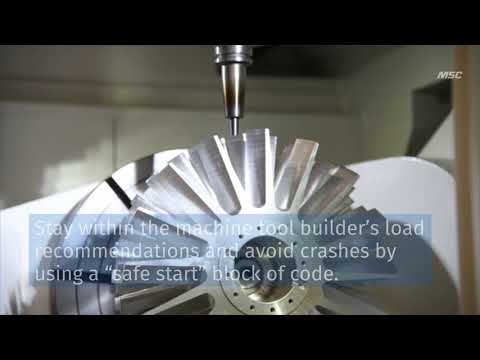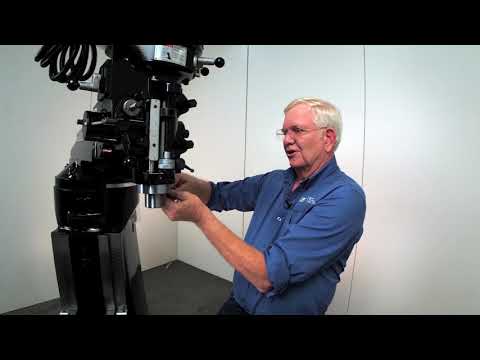
Over time, your spindles will usually break down due to wear and tear. But there are several smart steps you can take to improve a spindle’s life span.
The spindle is the heart of any machine tool. Unfortunately, it’s also the most prone to damage. One crash, a little neglect or some poor programming decisions and a shop might face weeks of downtime and a costly repair bill.
So while there are certainly unexpected mishaps, there are several steps you can take to avoid this unpleasantness while assuring maximum spindle life and predictable uptime.
“I break spindle care down into three categories—regular preventative maintenance, avoiding crashes and not overloading the spindle,” advises Dave Ward, product marketing manager at Makino Inc., who offers several “best practices” for each category.
“All of these must be addressed if you’re to achieve the greatest spindle life possible,” he notes.
Read more: Meet Guhring’s RT100XF: A High-Performance Carbide Drill Developed for Tough Metals
The Cost of Corrosion
For starters, Ward warns against using nicked, corroded or worn toolholders, as any damage to the taper (or flange face, in the case of dual-contact toolholders) will soon transfer to the spindle. Along these same lines, always invest in high-quality toolholders and steer clear of the “lowest cost provider” whenever possible, Ward adds.
On machines with through-spindle coolant, routine inspection of the O-ring or seal located at the toolholder/coolant tube interface is necessary to avoid contamination of the spindle cartridge from high-pressure cutting fluids. And recognize that crashes do not have to be catastrophic to cause spindle damage, Ward adds. Even stalling a spindle creates excessive bearing loads, and a “gentle” crash can create small dents in bearing surfaces that will accelerate spindle degradation.
Stay within the machine tool builder’s load recommendations and avoid crashes by using a “safe start” block of code. Doing so eliminates the chance that an operator will restart a program in the wrong position after an in-process part measurement or cutting tool replacement. Also, consider investing in toolpath simulation software, or spend the time necessary to walk through new part programs one block at a time.
Following Good Spindle Sense
Ward suggests those in the market for a new machine look for features like Makino’s Health Maximizer, which uses sensors in critical machine systems—including the spindle—to gather data about machine performance and alerts the user to potential problems.
There’s also Collision Safeguard, or CSG. As with toolpath simulation software, CSG reads machine G-code and compares it to solid models of the machine spindle, toolholders and workholding to detect potential crashes. However, Makino’s solution works in real time on the machine tool, even during manual machine movements.
Read more: Managing Downtime: A Guide to Improving Shop Productivity During Manufacturing Slowdowns
Finally, Ward says to watch your bending moment—in other words, don’t use overly long tools. These can exert enough radial force to cause “seal pickup,” where the rotating spindle shaft bends sufficiently that it interferes with nearby stationary areas.
“You can do an immense amount of damage to a spindle without ever crashing it,” he warns. “Ask your machine builder for a bending moment diagram for the spindle and use it to understand maximum length values for a given cutting tool and machining variables.”
Reducing Downtime in Detroit
Ted Ladzinski and his team perform thousands of spindle rebuilds each year. The owner of Motor City Spindle Repair, which specializes in rebuilding spindles for CNC machine tools, says many of the rebuilds he does could have been avoided or at least delayed had their users followed the best practices just listed.
“From my side, the two most common failure modes are crashes and contamination, with contamination falling into two categories—chips and coolant,” Ladzinski says.
To this point, filters should be changed regularly, he advises, and the compressed air feeding the machine should likewise be kept clean. So should cutting fluids, as these will inevitably make their way past spindle seals, no matter how good the spindle design. Turning off coolant during tool changes will help reduce some of this, as will keeping toolholders clean and well-maintained.
“Motor City Spindle has developed many different spindle upgrades to extend the spindle,” he notes.

“These include upgrading spindle bearing configurations, encapsulated motor winding, continuous spindle bearing monitoring and crash detection,” he adds. “Regardless of whether it’s our spindle or someone else’s, however, don’t push it past the point of no return. Imagine rebuilding an engine that has 100,000 miles on it versus one that’s locked up. The first rebuild is going to cost you a lot less. If the spindle starts to sound different or is getting warmer than it used to, it’s a good idea to plan ahead, scheduling the rebuild instead of waiting for it to freeze up in the middle of a rush job.”
A Spindle Balancing Act
Brendt Holden, president of Haimer USA, offers another reason for premature spindle failure: tool imbalance.
He says it’s a good idea to balance the complete toolholder assembly—the cutting tool, the toolholder and the retention knob as a single unit—for any spindle speeds greater than 8,000 rpm, and that it’s a must for 12,000 rpm and higher.
But hold on, you’re thinking: Our toolholders are pre-balanced. Why did we pay a premium price for them if we now have to spend even more money for a balancing machine, never mind all the time it will take us to balance everything?
Holden has several arguments, the first being that a tool balancer costs far less than replacing a worn or damaged spindle, especially when you consider the potential for weeks of downtime. And balanced cutting tools perform better, with increased tool life and better part finish, factors that typically pay for a tool balancing machine in 18 months or less.
Holden also recommends ditching Weldon shank tools and toolholders for those that are inherently balanced and provide greater holding force besides. At Haimer, this means one of the company’s shrink-fit, Safe-Lock or Power Collet chucks. These—and indeed all toolholders—should be used withpiloted pull studs, he adds, as they locate on a precision-ground journal and face rather than on the threads themselves.
“It’s the people who don’t have a balancing solution who say, ‘Well, pre-balancing is good enough. It should be fine,’” Holden says. “But that’s not reality. Imbalance causes runout, and runout causes a host of problems, even at lower rpm. In fact, I have one customer in the Phoenix area that was able to double their cutting parameters—from 3,000 rpm to 6,000 rpm with a corresponding increase in feed rate—after balancing their toolholder assemblies. With that in mind, balancing is a no-brainer.”
What steps have you taken in your shop to optimize the life span of your spindles?
Is It Time for a Spindle Speeder?
It’s happened to all of us.
You’re drilling a tiny hole or milling a tiny slot and the Machinery’s Handbook says you need 40,000 rpm.
Unfortunately, the machine only goes to 10,000 rpm.
Now what?
With some materials you’ll get away with throttling back on the feeds and speeds, but at the cost of shortened tool life, poor surface finish and unexpected tool breakage.
Fortunately, there is a better way. It’s called a spindle speeder. Air, electric, mechanical and even coolant-powered versions are available, with some reaching 100,000 rpm or more, and most can be used with the machining center’s ATC (although a drive block is often required).
Iscar’s Spinjet, for example, reaches up to 40,000 rpm and offers a wireless monitoring system.
And Nikken and MEC Precision are examples of the speeder heads that are readily available, which can solve the all-too-frequent problem of insufficient speed and do so for a relatively small investment.
Related Articles

Norton Abrasives’ Mini Flap Discs Prove That Little Things Can Make a Big Difference

Debunking Myths: Are You Over-Maintaining or Under-Maintaining Your Fluid System?

WALTER Presents: Driven by Challenge

ISCAR's MODULAR-GRIP Adapters and Jet High Pressure (JHP) System are a Winning Combination


